Archived Commercial Blog Posts
Why Businesses in Baytown and Channelview Need Professional Cleaning and Restoration Services
3/11/2025 (Permalink)
 Main HQ office and admin crew
Main HQ office and admin crew
Owning a business comes with many responsibilities, and maintaining a clean, safe environment is essential for employees and customers. From daily wear and tear to unexpected disasters like water damage or fire incidents, commercial properties require professional cleaning and restoration services. SERVPRO® of Baytown/Channelview offers specialized solutions to keep businesses operating smoothly.
Common Commercial Property Challenges
- Heavy Foot Traffic: Offices, retail stores, and restaurants experience constant foot traffic, leading to dirt buildup and floor damage.
- Water Leaks and Flooding: Plumbing failures, roof leaks, and storm damage can disrupt business operations and cause costly repairs.
- Fire and Smoke Damage: Even a small fire can create lingering smoke odors and require extensive cleanup.
- Mold and Indoor Air Quality Issues: Poor ventilation and high humidity can contribute to mold growth, affecting air quality and employee health.
SERVPRO® Commercial Services
- Deep Cleaning: Our commercial cleaning services include carpet cleaning, tile and grout cleaning, and HVAC system maintenance.
- Water and Fire Damage Restoration: We respond quickly to emergencies, ensuring minimal downtime for businesses.
- Mold Remediation: Our experts identify, remove, and prevent mold growth in commercial buildings.
- Biohazard and Disinfection Services: We provide professional sanitization services for healthcare facilities, offices, and industrial spaces.
Why Choose SERVPRO® of Baytown/Channelview for Commercial Cleaning and Restoration?
- 24/7 Emergency Response: Disasters don’t wait, and neither do we. Our team is available around the clock.
- Minimized Business Disruptions: We work efficiently to get businesses back to normal as quickly as possible.
- Customized Cleaning Plans: We tailor our services to meet the unique needs of each business.
- Insurance Assistance: We coordinate with insurance providers to simplify claims and reduce downtime.
For reliable commercial cleaning and restoration services in Baytown and Channelview, trust SERVPRO® of Baytown/Channelview. Contact us today to schedule a consultation or emergency service.
What Should I Look For In a Fire Restoration Company
10/16/2022 (Permalink)
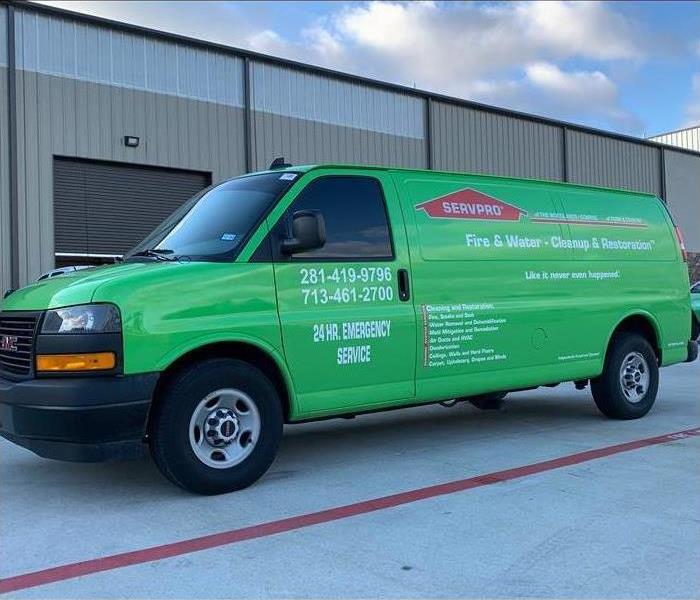 Choose SERVPRO of Baytown/Channelview to restore your Houston home or business after a fire!
Choose SERVPRO of Baytown/Channelview to restore your Houston home or business after a fire!
Hiring the Right Fire Restoration Company
If you’ve had a fire, you need to hire the right company to restore your home. The wrong company can delay the process, or even make it worse. Here are some things to consider.
Look for Specialized Training
As you look at potential fire restoration companies, look for those that have specialized training in this field. For example, if you are looking to restore your home after a fire, ask your fire restoration company if they have been trained by an organization such as the American Society of Cleaning and Restoration Specialists (ASCR). This will give you peace of mind knowing that your home is being handled by professionals who know what they're doing.
There are various certifications available to help support the quality of a fire restoration company’s work—and to verify that the company has met certain standards or criteria before being able to offer its services. Certifications can include the Fire Damage Restoration Certification. This certification assures that a firm has experience with this particular type of damage and can do it well. It also verifies compliance with local regulations on business practices related specifically to maintaining professional competence within the industry.
Look for Experience
The best way to determine if a company has experience in dealing with smoke and soot damage is by checking its portfolio. If they have pictures of their work, you can use the images to compare them with your own home or business. If they don't have any images on hand, you can ask them for references or call local fire departments for recommendations.
Another good indication that a company knows what it’s doing is certification from organizations such as the IICRC (Institute of Inspection Cleaning and Restoration Certification). This certification is based on standards set by industry professionals and will give you confidence that you're getting quality work from an accredited professional.
Check for Subcontractors
When choosing a fire restoration company, it's important to ask whether they use subcontractors or not. If you decide to hire a subcontractor, make sure they are insured and licensed. You should also ensure that they have their own team of qualified workers who can be held accountable for the quality of their work.
The benefit of using a subcontractor is that they may be able to provide low-cost service. However, this can come at an increased risk because there may not be as much oversight or accountability when dealing with a third-party company compared to working with an established fire restoration firm directly.
Fire damage restoration is a special field, and not just for the mess. Fire damage restoration companies are contracted to restore a property to its original condition. This means that they not only have to clean up the ashes and charred materials, but also repair any damaged areas of the property and make sure that it's safe for people to return home again.
We hope this guide has helped you understand what to look for in a fire restoration company. We know that it can be difficult to find the right company, but we are confident that your luck will change when you choose SERVPRO of Baytown/Channelview to restore your Houston home or business after a fire! Just remember to ask questions and do your research before making any decisions.
3 Common Effects of Water Damage on Ceiling Tiles
8/30/2022 (Permalink)
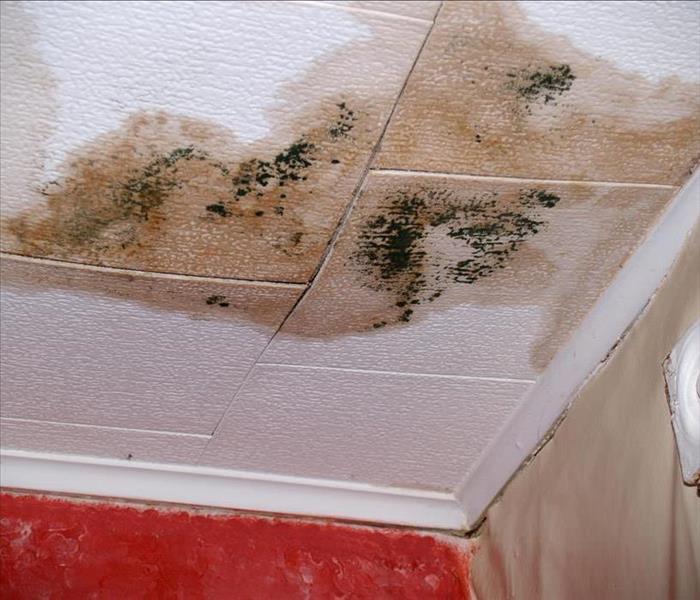 Water damage on ceiling tiles caused secondary damage
Water damage on ceiling tiles caused secondary damage
Water Damage To Ceiling Tiles
Water damage can have telltale effects on the appearance and condition of the tiles on a ceiling. Short of tile mold, visible signs of disintegration, distortion or staining may be evident. Find out more about three common effects leaks can have on commercial ceiling tiles at a building located in Highlands,TX.
1. Causing Stains To Appear On Tiles
As soon as water makes contact with expanded polystyrene, fiberglass, cork, or other ceiling materials, stains may start to become apparent. Tile discoloration may not be immediately discernible, but dried damage from water on various ceiling styles tends to turn the tiles brown over time. Signs of problems may become more visible in the following days, weeks and months if the owner or building manager fails to undertake water damage restoration.
2. Distorting the Texture of the Ceiling
Nearly any type of ceiling material becomes distorted in appearance after moderate to major damage involving water. Fast leaks from plumbing supply lines or a big breach in roofing materials may cause ceilings to sag or swell. A slow leak may not show signs of a distorted texture until tile mold starts to grow. Mold may be fuzzy, spongy, or slimy in appearance and tends to grow in patterns.
3. Undermining the Ceiling Materials
Porous ceiling materials will not be the same after saturation with water. Ceilings may start to crack, crumble or flake and leave behind residues on floors and surfaces. It is often necessary to replace absorbent ceiling materials such as polystyrene, cork, or fiberglass. It may be possible to clean mold off of plastic or metal commercial ceilings.
Commercial property owners or managers may notice a distorted texture or staining before ceiling tiles start disintegrating. It is important to act quickly to limit damage and risks of occupant exposure to tile mold. Schedule an inspection to determine the cause and degree of damage to a building in Baytown, TX.
3 Reasons Why Mold Might Form in Your Business Property’s HVAC System
5/27/2022 (Permalink)
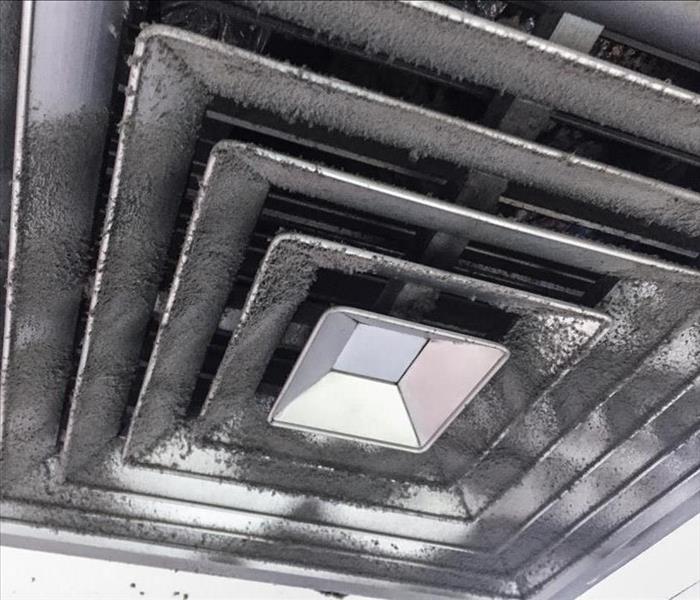 Keep your air ducts clean
Keep your air ducts clean
Why Mold Might Form in Your Business Property
Protecting your Mcnair, TX, business from a mold invasion can be challenging, especially when it hides in places you least expect. Black mold is usually the most common and most widespread type of mold you might encounter, especially in your building’s heating, ventilation and air conditioning system. This might seem strange, as the system is enclosed by ductwork, but there are several reasons why mold might form there.
1. The Humid Environment
Your building’s HVAC system is a complicated maze of air ducts that foster a warm, humid environment, which is the perfect setting for mold growth. Most kinds of fungi thrive in such a setting, and if your building is naturally humid, this may only increase the problem. Taking steps to decrease moisture can lower the risk of mold growth in your HVAC ducts.
2. Incorrect AC Unit Size
When your air conditioner is either too large or too small for the building it cools, it can encourage mold growth. For example, a system that is too large may run in shorter cycles and fail to dehumidify the building’s air, which may increase moisture in the ductwork. Many types of fungi, including black mold, can thrive when this occurs. Over time, you may notice a musty, unpleasant smell when you use the system as the growth spreads and grows larger.
3. Duct Leaks
If your building’s HVAC ducts have leaks, this can allow warm air to seep in and meet with the colder air inside the system, which creates a moist environment where mold can grow. Calling in a mold mitigation and removal service to clean ducts and repair the leakage may improve the way your system operates and reduce the risk of mold growth.
Black mold and other types of fungi in your HVAC system can have a negative impact on your Mcnair, TX, business. Knowing what might cause this problem can help you prevent and recognize it so you can reach out for help before it gets worse.
3 Warning Signs of a Bad Fire Cleanup Estimate
5/17/2022 (Permalink)
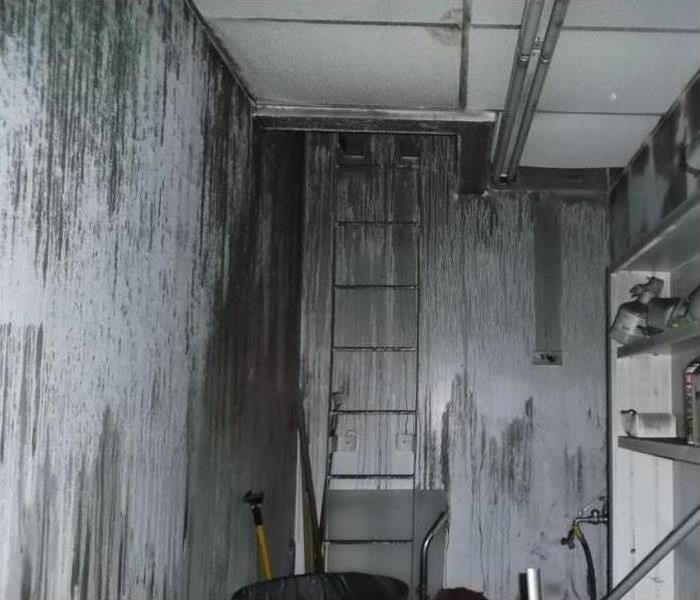 Smoke damage in Highlands, TX.
Smoke damage in Highlands, TX.
Three Signs Your Fire Cleanup Estimate Isn't Up to Par
While it is possible that your company in Highlands, TX, will never face a damaging fire, this is not a certainty. The National Fire Protection Association reported that in 2020 nearly 500,000 structure fires occurred in the U.S. If a fire does break out in your facility, you will have to deal with an assortment of complicated tasks, from working with your insurance company to reviewing an estimate from a fire restoration team. When looking over the details of a bid for services, keep an eye open for certain warning flags.
1. A Brief Description of Services
If the document you receive is short on details, it could be a bad sign. This could either indicate that the contractor is inexperienced or is looking for an excuse to overcharge. The bid should include information on most if not all of many essential services: roof board up, roof replacement, security guard surveillance, damage restoration, smoke odor removal and debris removal. The estimate should also include itemized costs for restoration services.
2. A Failure To Designate a Primary Contact
It is always advantageous to have a specific person to contact for questions and concerns after a commercial fire. After all, the very survival of your business could be at stake. If this isn't included or offered, it could be a sign that you will have difficulty reaching a knowledgeable person. The project manager should be listed on the bid as well as his or her contact information.
3. A Mention of Other Fire Damage Contractors
If the bid mentions a series of contractors, it might be a good time to look elsewhere. A full-service contractor will likely be more knowledgeable and experienced and the overall cost will likely be lower. Even the claims process with insurance is apt to go better with one contractor.
A professional estimate should give you a sense of confidence. It should spell out the details of the cleanup process.
Can Mold Grow Inside Your Building’s HVAC System?
3/31/2022 (Permalink)
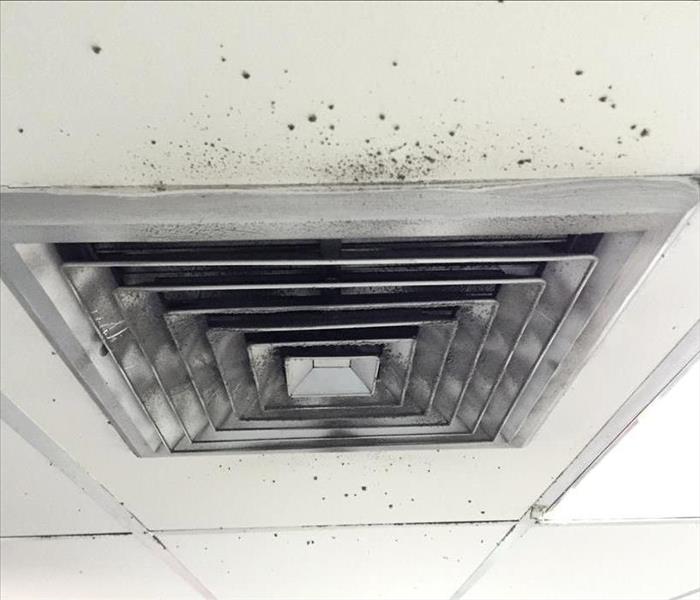 The presence of dust speeds up mold growth.
The presence of dust speeds up mold growth.
Mold spores are everywhere in your commercial building. They typically aren’t cause for alarm unless they gather into mold clusters and start spreading throughout the facility. Mold thrives in a warm, moist environment and grows even more quickly in dark places. These conditions make your building’s heating and cooling system a prime area for mold growth. It’s critical to schedule an HVAC cleaning periodically to keep mold under control.
How Mold Grows Inside Your HVAC System
Your building’s HVAC system is made up of many different parts, including:
- Filters
- Ducts
- Exhaust outlets
- Blower
- Compressor
- Coils
As dust settles, it begins to accumulate inside the air ducts, filters and coils inside your HVAC system. Since dust is a food source for mold, the presence of dust speeds up mold growth. When combined with the other perfect conditions like humidity and darkness, mold can grow unchecked in your HVAC ducts.
An HVAC system is designed to blow warm and cold air into your building, forcing these mold clusters to settle on all surfaces and structures. Over time, mold can cause significant damage to these structures, which is why an HVAC cleaning is so critical.
How To Detect Mold
Hidden mold can grow unchecked. The process of cleaning vents is the only way to know for sure if you have mold inside the HVAC ducts. It’s critical to note, however, that this maintenance must be performed by professionals. They have the equipment and cleaning supplies necessary to do the job thoroughly and carefully.
Frequently, hidden mold can also be detected by its unpleasant odor. If you suspect serious mold growth, you should contact a mold remediation specialist right away to inspect the building and develop a comprehensive plan to remove it.
Reduce the risk of mold damage inside your commercial building in Liberty, TX, by scheduling an HVAC cleaning as soon as possible.
Why Do Burned Buildings Have Tarps on the Roof?
1/25/2022 (Permalink)
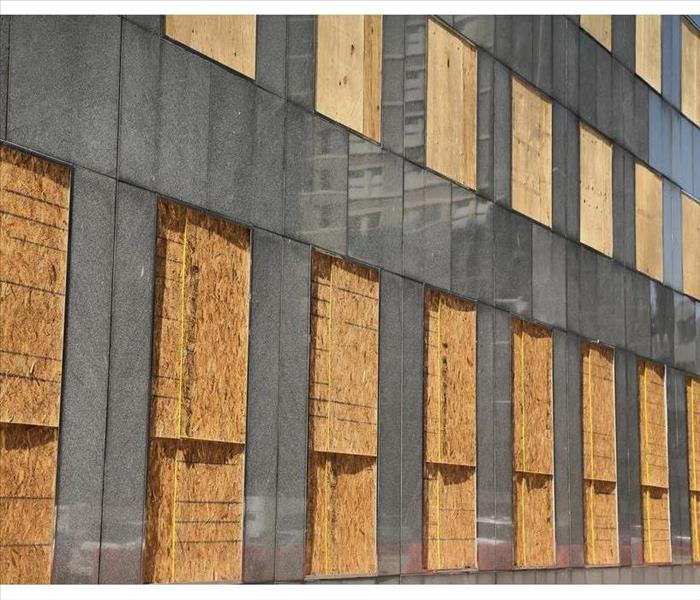 Board up services to a building in Baytown, TX.
Board up services to a building in Baytown, TX.
Fire Restoration Process
You may have passed by a recently burned building in Baytown, TX, and wondered why the restoration company has placed a tarp over the roof. If the commercial fire occurred in a large business park, it can be unsightly, and you may wonder what purpose it might serve. As it turns out, tarping the premises has multiple purposes, but to get a proper grasp on its usefulness, it’s helpful to understand the fire restoration process as a whole. Here is a basic rundown of the fire restoration process as it relates to tarping the ceilings:
Damage Inspection
The fire cleanup process is laborious and often difficult, but much of that work is made easier by the first step. Fire restoration professionals should come equipped with technology that allows them to assess the severity of damage to the affected area and the contents within. Though it doesn’t take high-tech equipment to determine whether a ceiling has been burned out, this process still gives restoration professionals a solid foundation on which they can structure their restoration efforts.
Board and Tarp Services
Once the restoration professionals have a solid understanding of what can be restored and what must be replaced, they set to work on boarding up destroyed windows and tarping destroyed ceilings. This is an important part of the fire cleanup process. Since the contents caught in the fire are already in a vulnerable condition, it’s important to protect them from the elements. For example, a wooden chair that has been heavily damaged by smoke and soot might pass the point of no return if a torrential downpour of rain comes through the ceiling. Similarly, boarding up the windows also protects contents from the elements as well as looters.
Final Steps
Once the windows are boarded and roofs tarped, restorers have a secure environment to work in. They will set to work on finishing the fire cleanup process by restoring salvageable contents and conducting important remodeling procedures like drywall and roof repair.





 24/7 Emergency Service
24/7 Emergency Service






